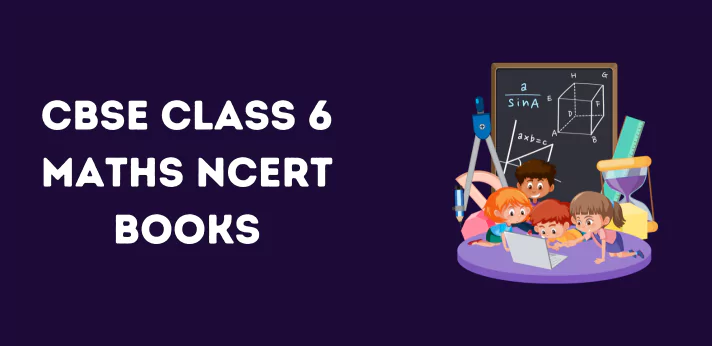CBSE Class 6 Maths NCERT Books: The upcoming board exam candidates must consider the NCERT books for Class 6 Maths CBSE as essential resources. These textbooks, available in chapter-wise PDF format, represent the revised and latest editions republished by the National Council of Educational Research and Training (NCERT) for the current academic session. NCERT has rationalized the content of the old books, resulting in the deletion of certain portions to streamline the chapters for students. Students must read all chapters of the new Class 6 Maths NCERT Books to prepare the right content for their Class 6 Maths Board Exams in 2025.
[Index]
Overview
Before we discussed the CBSE Class 6 Maths Book, let us check the CBSE Class 6 Maths Summary. It will help you to choose the best and most appropriate books for CBSE Examination. Below we have mentioned the complete CBSE Class 6 Maths Summary.
| Particulars | Description |
| Class | 6th |
| Board | CBSE (Central Board of Secondary Education) |
| Subject | Maths |
| Category | NCERT Books |
| Study Materials | Click Here |
| Class 6 Free E-Book | Click Here |
| Youtube Channel | Subscribe now |
CBSE Class 6 Maths NCERT Book
NCERT Textbooks are developed by highly talented think tanks in our country, making these books very useful for the students. Be it Engineering or State services or any other National or State level entrance examination, NCERT Text Books are the first things that a student have while aiming for Something. You can download Class 6 Maths NCERT Books from the below downloadable links in PDF Format.
Maths NCERT Books for Class 6
CBSE Class 6 Maths Syllabus 2024-25
Understanding the Maths, Mathematical questions and other mathematical operation which is a concern for Class 6 Mathematics. Let us now discuss the CBSE Class 6 Maths syllabus with topics to be covered and the month assigned.
| Chapter Name | Topic to be Covered |
| Chapter 1: Knowing Our Numbers | 1.1 Introduction 1.2 Comparing Numbers 1.3 Large Numbers in Practice 1.4 Using Brackets 1.5 Roman Numerals |
| Chapter 2: Whole Numbers | 2.1 Introduction 2.2 Whole Numbers 2.3 The Number Line 2.4 Properties Of Whole Numbers 2.5 Patterns in Whole Numbers |
| Chapter 3: Playing With Numbers | 3.1 Introduction 3.2 Factors and Multiples 3.3 Prime and Composite Numbers 3.4 Test For Divisibility Of Numbers 3.5 Common Factors and Common Multiples 3.6 Some More Divisibility Rules 3.7 Prime Factorisation 3.8 Highest Common Factor 3.9 Lowest Common Multiple 3.10 Some Problems on HCF and LCM |
| Chapter 4: Basic Geometrical Ideas | 4.1 Introduction 4.2 Points 4.3 A Line Segment 4.4 A-line 4.5 Intersecting Lines 4.6 Parallel Lines 4.7 Ray 4.8 Curves 4.9 Polygons 4.10 Angles 4.11 Triangles 4.12 Quadrilaterals 4.13 Circles |
| Chapter 5: Understanding Elementary Shapes | 5.1 Introduction 5.2 Measuring Line Segments 5.3 Angles-’Right’ and ‘Straight’ 5.4 Angles- ‘Acute’, ‘Obtuse’ and ‘Reflex’ 5.5 Measuring Angles 5.6 Perpendicular Lines 5.7 Classification of Triangles 5.8 Quadrilaterals 5.9 Polygons 5.10 Three Dimensional Shapes |
| Chapter 6: Integers | 6.1 Introduction 6.2 Integers 6.3 Addition of Integers 6.4 Subtraction of Integers with the help of a Number Line |
| Chapter 7: Fractions | 7.1 Introduction 7.2 A Fraction 7.3 Fraction on the Number Line 7.4 Proper Fractions 7.5 Improper and Mixed Fractions 7.6 Equivalent Fractions 7.7 Simplest Form of a Fraction 7.8 Like Fractions 7.9 Comparing Fractions 7.10 Addition and Subtraction of Fractions |
| Chapter 8: Decimals | 8.1 Introduction 8.2 Tenths 8.3 Hundredths 8.4 Comparing Decimals 8.5 Using Decimals 8.6 Addition of Numbers with Decimals 8.7 Subtraction of Decimals |
| Chapter 9: Data Handling | 9.1 Introduction 9.2 Recording Data 9.3 Organisation of Data 9.4 Pictograph 9.5 Interpretation of a Pictograph 9.6 Drawing a Pictograph 9.7 A Bar Graph |
| Chapter 10: Mensuration | 10.1 Introduction 10.2 Perimeter 10.3 Area |
| Chapter 11: Algebra | 11.1 Introduction 11.2 Matchstick Patterns 11.3 The Idea Of A Variable 11.4 More Matchstick Patterns 11.5 More Examples of Variables 11.6 Use Of Variables in Common Rules 11.7 Expressions with Variables 11.8 Using Expressions Practically 11.9 What is an Equation? 11.10 Solution of an Equation |
| Chapter 12: Ratio and Proportion | 12.1 Introduction 12.2 Ratio 12.3 Proportion 12.4 Unitary Method |
Class 6 Study Material
We have tried to bring CBSE Class 6 NCERT Study Materials like Syllabus, Worksheet, Sample Paper, NCERT Solutions, Important Books, Holiday Homework, Previous Year Question Papers etc. You can visit all these important topics by clicking the links given.

Where can I download the pdf
Click on chepter